General Information
| All of our books come as fully typeset, commercial quality productions, with a great deal of attention to detail. This is equally true for books on paper and for e-books (which we deliver as PDF's). | |
| E-books will generally be sent to you within two days by e-mail. Note that we are sometimes out of the office and that our office is open for normal hours, not around the clock or on weekends. Books on paper will be sent to you by mail using the best delivery method. | |
| When you click a purchase button, it will open a shopping basket. If you need more than one item, just come back to this page or go to any other page where products are for sale and click on another item. The shopping basket will appear with all items showing. When you are ready, make the purchase. | |
| Shipping costs for paper books: to purchase multiple books on paper, contact us with a list of the books you wish to purchase and we will send you a shopping basket by return e-mail with the correct shipping applied. This will reduce your shipment cost significantly. | |
| If you need further assistance, please use the please use the contact link on the menu to contact us. |
Special Feature: Tibetan texts
|
Our goal is to provide dharma books of the highest quality that give the greatest possible
access to the dharma materials involved. Therefore, many of our books have the relevant Tibetan text(s)
included. If not and you need the text, you can always ask for it and we will try to help. We also try to provide the Tibetan texts associated with each book as electronic files that can be read, searched, and used as part of an electronic Tibetan reference library. You can read about making an electronic reference library and obtaining the reader software needed • here. |
Titles in Print

| Tibetan Grammar Books |
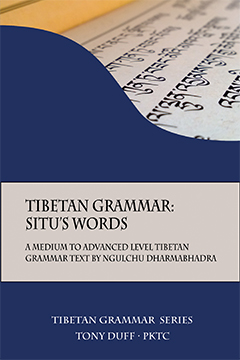
|
We have the most comprehensive range of Tibetan grammar texts and explanations of Tibetan grammar available anywhere. Our
books on Tibetan grammar will show you, for the first time, Tibetan grammar as Tibetans understand it. If you are a translator, these books will make a world of difference to your ability to translate Tibetan accurately and effectively. Details, purchase ...
Details, purchase ...
|

| Kindle Books and E-books |

| Many of our books are available as e-books. We provide e-books in both
PDF format and Kindle format. Some people have asked why we do not make other e-book formats. There are
various reasons but PDF e-books can be read on any device, so this format serves everyone's needs. Complete listing of our Kindle books and purchase ...
Complete listing of our Kindle books and purchase ...
|
 Paper books and E-books
Paper books and E-books
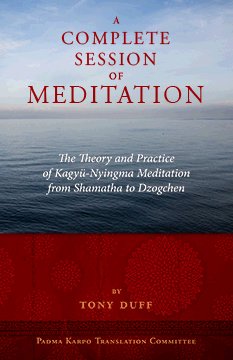
Complete instructions on Kagyu-Nyingma meditation from sugata essence to Mahamudra and Dzogchen by Lama Tony Duff
| Title | A Complete Session of Meditation |
| Sub-title | The Theory and Practice of Kagyu-Nyingma Meditation from Shamatha to Dzogchen |
| Author | Tony Duff |
| Details | 198 pages, 5.5" X 8.5", US$25, available on paper and in PDF e-book formats |
| ISBN | paper book 978-9937-572-71-2, e-book 978-9937-572-72-9 |
| Language | English and Hungarian books available; for the Hungarian version • go here |
This is a book of teachings on how to do a complete session of meditation. The book was composed by the Western teacher, Lama Tony Duff, to help those who would like to practise meditation in general. However, it will be especially useful for those who would like to practise according to the ways of the Kagyu and Nyingma traditions of Tibetan Buddhism. The book emphasizes the practical style of instruction found in those two traditions. It deliberately avoids the scholarly style taught in some other Tibetan Buddhist traditions and focusses on actually doing something with one's own mind. Nonetheless, the book is very precise and clear about all of the key points involved in meditation practice.
The book emphasizes the Kagyu approach in particular. The author has received teachings from many Kagyu masters and used his knowledge of the tradition as a basis for making this book. He selected teachings from Gampopa and other early masters to set the basis for explaining meditation. Then he added other, necessary teachings according to the extensive teachings he has received over many years from many different Kagyu masters, such as Chogyam Trungpa Rinpoche, Mingyur Rinpoche, and others. The result is a book that explains how to do a complete session of meditation in the style of the Kagyu and Nyingma traditions.
The book begins with a lengthy introduction by Lama Tony which is a teaching in its own right. He writes a lengthy piece about what can and cannot usefully be obtained from science in terms of dharma practice. Following the introduction, there are two chapters on the buddha nature, the second of which uses a significant portion of Dolpopa Sherab Gyaltsen's explanation of the ground in his famous Mountain Dharma text. This is the first time that this part of Dolpopa's text has been fully translated and published. After that are several chapters on the various steps of a complete session of meditation. Anyone who practises meditation will find this book useful in many ways.
The book contains a translation of the following text:
 | "Mountain Dharma, An Ocean of Definitive Meaning" by Dolpopa Sherab Gyaltsan, ground section |
Download Tibetan text in TibetD format: no Tibetan text in this book.
Purchase:
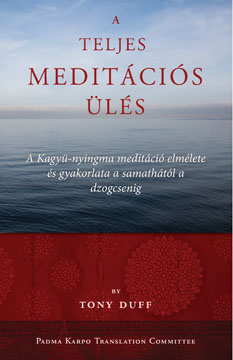
Lama Tony Duff, Magyar fordítás Agócs Tamás
| Title | A teljes meditációs ülés |
| Sub-Title | A Kagyü-nyingma meditáció elmélete és gyakorlata a samathától a dzogcsenig |
| Author | Tony Duff, Magyar fordítás Agócs Tamás |
| Details | 198 oldal, 5.5" X 8.5", 5000 Forint |
| ISBN | papírkönyv 978-9937-572-75-0, e-könyv 978-9937-572-76-7 |
| Language | Magyar; for the English version • go here |
E könyv tanításai arról szólnak, hogyan kell lefolytatni egy teljes meditációs ülést. A könyvet egy nyugati tanító, Lama Tony Duff állította össze azoknak segítségül, akik meditációt szeretnének gyakorolni általában. Azoknak pedig, akik a tibeti buddhizmus kagyü és nyingma iskolái szerint kívánnak gyakorolni, különösen hasznos lehet. E könyv az említett két hagyományban megtalálható, praktikus stílust helyezi előtérbe. Szándékosan kerüli az egyes más tibeti buddhista hagyományokban alkalmazott tudományos hangvételt, és arra a kérdésre összpontosít, mit tehet az ember konkrétan a tudatával. Ennek ellenére igen pontosan és világosan írja le a bemutatott meditációs gyakorlatok kulcspontjait.
A könyv különösen a kagyü megközelítést emeli ki. A szerző a hagyományról szóló, széleskörű elméleti és gyakorlati tudására támaszkodott e könyv megalkotásakor. Gampópától és más korai mesterektől választott ki néhány tanítást, hogy megvesse a meditációr ól szóló magyarázatok alapjait. Az egyéb szükséges tanításokat azon terjedelmes tanítások közül válogatta össze, melyeket több különböző kagyü mestertől – többek között Cshögyam Trungpa és Mingyur Rinpócséktől – kapott az évek során. Az eredmény egy olyan könyv lett, amely igen világosan elmagyarázza, hogyan kell lefolytatni egy teljes meditációs ülést a kagyü és nyingma hagyományokban.
A könyv Lama Tony hosszú bevezetőjével kezdődik, mely maga önálló tanítás. Hosszasan értekezik arról, hogy a tudomány mennyiben lehet hasznunkra, és mennyiben nem, a Dharma gyakorlásában. A bevezetőt két fejezet követi a buddha-természetről; a második Dolpópa Serab Gyalcen híres szövege, a Hegyi Dharma, talajról szóló magyarázatainak tekintélyes részét használja fel. Dolpópa e szövegrészletének ez az első teljes, megjelent fordítása. Az ezt követő fejezetek a teljes meditációs ülés különböző lépéseit taglalják. A könyvet mindenki haszonnal forgathatja, aki meditációs gyakorlatokat szokott végezni.
A könyv a következő szöveg fordítását is tartalmazza:
 | Dolpópa Serab Gyalcen: "Hegyi Dharma, A bizonyos jelentés óceánja". talaj szakasz |
Purchase:

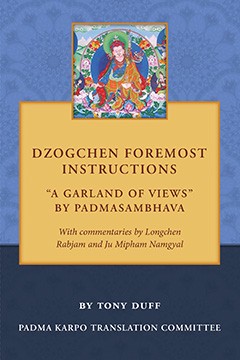
Texts by Padmasambhava, Longchen Rabjam, and Ju Mipham concerning the Dzogchen instructions in the Guhyagarbha tantra, with translation and explanations by Tony Duff
| Title | Dzogchen Foremost Instructions, "A Garland of Views" by Padmasambhava |
| Sub-Title | With commentaries by Ju Mipham and Longchen Rabjam |
| Author | Tony Duff |
| Details | 218 pages, 3 colour plates, 6" X 9" (large format), US$25 |
| ISBN | paper book 978-9937-572-84-2, e-book 978-9937-572-81-1 |
| Texts | Tibetan texts in Tibetan script included |
The text Foremost Instructions called "A Garland of Views" by Padmasambhava is regarded as one of the very important texts of the Nyingma tradition. It is an explanation of the thirteenth chapter of the root tantra of Mahayoga, the Guhyagarbha Tantra, the chapter on how the view of Dzogchen applies to the deity practices of Mahayoga. Padmasambhava's teaching is short, so further explanation is needed. For this we have provided a partial translation of the thirteenth chapter with explanations, Mipham's commentary which is the one most commonly used these days to explain Padmasambhava's teaching, and a translation of the relevant section of Longchen Rabjam's major commentary to the tantra Dispelling the Darkness of the Ten Directions. A very long introduction filled with explanations to make all of those items clearer has been provided.
It is very important to understand that the teachings on Dzogchen in this book are not limited to instructions on the development stage of Mahayoga. They provide a complete explanation of what Dzogchen is at all levels and are regarded in the Nyingma tradition as required reading for all Dzogchen practitioners. Through this book you will gain an excellent grounding in what Dzogchen is and how it fits into the teachings of the nine vehicles.
This book is truly an amazing collection of material that is regarded as crucial for Nyingma practitioners, but has not been available till now in English with all the commentaries needed to unravel the meaning of Padmasambhava's text. The Western Lama Richard Roth, who has been well-trained in the Dzogchen system, has said what an important and well-presented book this is.
The book contains a translation of the following texts:
 | Foremost Instructions called "A Garland of Views" by Padmasambhava |
 | Mipham's Annotational Commentary "A Warehouse of Jewels" to Padmasambhava's teaching |
 | The first half of the thirteenth chapter of the Guhyagarbha Tantra, the root tantra of Mahayoga |
 | Longchenpa's explanation of the first half of the thirteenth chapter of the Guhyagarbha Tantra, from his very famous commentary "Dispelling the Darkness of the Ten Directions" |
Download Tibetan text in TibetD format: not available yet.
Purchase:


A Complete Explanation of Thorough Cut by Zhabkar, with explanations by Ontrul Tenpa'i Wangchuk and Tony Duff
| Title | Flight of the Garuda |
| Sub-Title | A Complete Explanation of Thorough Cut by Zhabkar |
| Author | Tony Duff |
| Details | 248 pages, 2 colour plates, 6" X 9" (large format), US$25, available on paper and in Kindle e-book format |
| ISBN | paper book 978-9937-572-05-7, e-book 978-9937-572-04-0 |
| Texts | Tibetan texts in Tibetan script included |
Flight of the Garuda is a series of twenty-three songs sung by the Dzogchen master Tshogdrug Rangdrol [1781–1850 C.E.] for the sake of his students. The songs explain the practice called Thorough Cut (Thregcho), which is one of the two innermost practices of Dzogchen or Great Completion. Tshogdrug Rangdrol, who is more commonly known as Zhabkar, later compiled the songs into a text. Over time, this text became one of the most popular texts used to explain Thorough Cut because of its complete and very clear treatment of the practice.
Zhabkar went further and made Flight of the Garuda into the first of a trilogy of texts. The other two texts in the trilogy explain the second innermost practice of Dzogchen, called Direct Crossing (Thogal). These two texts are not included in this book, though a clear explanation of all three texts in the trilogy is given in the introduction. Note that the second text of the trilogy is essentially the famous text by Jigmey Lingpa Guidebook called "Highest Wisdom" (Triyig Yeshe Lama) re-arranged by Zhabkar and put into verse. Jigmey Lingpa's text is available in English through PKTC, which means that there is way to obtain the content of the second text of the trilogy without it being translated into English. The third text of the trilogy contains personal instructions on Thogal which were meant for Zhabkar's students and which might not be suitable for publication in English.
The translation here is a fresh translation of Flight of the Garuda which improves considerably on two earlier translations. The translation was made by Lama Tony in Tibet, while receiving an extended teaching on the entire text by the great treasure revealer Ontrul Tenpa'i Wangchuk. The translation benefits from the exceptional knowledge and high realization of this master and the general atmosphere of pure blessings of the Nyingthig Dzogchen (Quintessence Great Completion) tradition in his retreat centre.
Those who have read either of the other translations available will be surprised and delighted at this translation. Verse and prose versions of the translation are provided to accomodate all needs. A summary of topics of the text, by Ontrul Tenpa'i Wangchuk, which has not been seen before and which helps considerably to understanding the many topics within the text itself has been included.
A lengthy introduction helps the reader understand the background to the text. Extensive footnotes and a long glossary have been provided so that the reader can clearly understand all the details involved.
Ontrul Tenpa'i Wangchuk's principal lineage of Dzogchen teachings is that of Dzogchen Monastery, Tibet. Dza Patrul is an early figure of the same lineage who wrote a very famous commentary on Thorough Cut called Feature of the Expert Glorious King; Ontrul Tenpa'i Wangchuk has written a commentary to it which is available from PKTC under the title Relics of Dharmakaya.
The book contains translations of the following texts:
 | Song of the View of the Thorough Cut of Luminosity Great Completion Called "Flight of the Garuda Capable of Quickly Traversing All the Levels and Paths" |
 | A Summary of the Guidebook to the Thorough Cut View, Flight of the Garuda, Called "A Key to Unravel the Treasury of the Three Lineages' Instructions" |
Download Tibetan texts in TibetD format: available here
Purchase:


Dzogchen text by Jigmey Lingpa, translations and explanations by Tony Duff
| Title | Highest Wisdom |
| Sub-Title | A Guidebook to The Stages of Path of the Primal Guardian According to Longchen Nyingtig Great Completion by Jigmey Lingpa |
| Author | Tony Duff |
| Details | 352 pages, 2 colour plates, 6" X 9" (large format), hardcover, stitched binding, US$85, available on paper |
| ISBN | paper book 978-9937-838-60-3 |
| Texts | Tibetan text in Tibetan script included |
The text here by Jigmey Lingpa is commonly known by its abbreviated Tibetan name, Triyig Yeshe Lama or Guidebook Called "Highest Wisdom". It is the central text in the Longchen Nyingthig tradition of Great Completion or Dzogchen, and is used to explain the highest practices of the system.
The author, Lama Tony Duff, has spent much time at Dzogchen Monastery, East Tibet, receiving the complete transmissions of the Longchen Nyingthing system. He made and verified this translation during attendance at a number of extended teaching retreats on the text. Thus, the translation bears the blessings of one of the greatest living holders of the Longchen Nyingthig lineage, Padma Kalzang Rinpoche. The blessings are conveyed to those outside of Tibet through the author, who is one of the very few translators capable of receiving, understanding, and practising teachings in the purely Tibetan environment found in the depths of Tibet. These blessings are beautified with the ornaments of practical knowledge passed on to the author by the many yogins and khenpos steeped in the tradition, his close friends who live permanently in mountain retreats at the monastery. Tibetan lamas who know the Longchen Nyingthig teaching and who can speak English sufficiently well to judge the matter say that it is by far the best translation available in English.
It has to be said that this Guidebook Called "Highest Wisdom" is sealed and locked. The reason for this is that the text is a summation of the key points for practice found in the Seventeen Tantras, the tantras which are the very root of Great Completion. Those tantras explicitly warn that one must have the necessary empowerments, and so on, before beginning to be instructed in and read about these teachings. This is not a meaningless requirement; there is great danger in reading this material without first having the necessary empowerments and related instructions. Therefore, there is a mandate by the lineage that this text is only to be read after having received the Rigpa Liveliness Empowerment (Tib. rigpa'i tsal wang) or by those who are about to receive it during a session of teaching on the text.
The book contains a translation of the following text:
 | "Highest Wisdom", A Guidebook to The Stages of Path of the Primal Guardian According to Longchen Nyingtig Great Completion by Jigmey Lingpa |
Download Tibetan texts in TibetD format: This text is part of the Root Volumes of Longchen Nyingthig which is available from PKTC free • here.
Purchase:

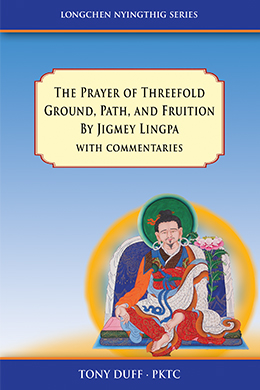
by Jigmey Lingpa with three commentaries included, translations and book by Tony Duff
| Title | The Prayer of Threefold Ground, Path, and Fruition |
| Sub-Title | by Jigmey Lingpa with Commentaries |
| Author | Texts by Jigmey Lingpa, Yontan Gyatso, and Tshewang Chogdrub; translations and book by Tony Duff |
| Details | 220 pages, 1 colour plate, 6" X 9" (large format), US$30, available on paper and in PDF e-book format |
| ISBN | paper book 978-1532-396-27-4, e-book 978-1532-396-26-7 |
| Texts | Prayer text in Tibetan script included, commentary texts in Tibetan script available by download, see below |
The primary purpose of this book is to make the prayer called "The Prayer of Threefold Ground, Path, and Fruition" available in English for practitioners of the Dzogchen teaching. The Prayer came into this world through what is called the Longchen Nyingthig tradition of the Dzogchen teaching. As is explained extensively in the very long and comprehensive introduction to the book, Longchen Nyingthig is the name for one of several transmissions of the most profound level of Dzogchen teaching that appeared in Tibet.
In Tibet, daily recitation of the Prayer is an essential part of the practice of those who follow the Longchen Nyingthig tradition of the Dzogchen teachings. More than that though, it is such an amazing presentation of the most profound level of Dzogchen teaching that it is widely used by Dzogchen practitioners in general. With that in mind, this book was produced so that all English-speaking practitioners of the Dzogchen teaching would have full access to the prayer.
The prayer is very condensed. It contains, in just nine four-line verses, the whole meaning of profound Dzogchen as understood by Longchen Rabjam. Because of that, even those who know the Dzogchen teaching will find it hard to comprehend the full import of the prayer. Therefore, this book starts with the prayer, then has an outline of the meaning of the verses of the prayer, followed by a short commentary and then a long commentary to the prayer. For many people the brief outline and short commentary will be sufficient to enable them to recite the prayer in a meaningful way. For others who need a very detailed explanation of the prayer, the longer commentary will provide that.
It does have to be noted that the longer commentary not only gives a more detailed explanation of the prayer but a significantly more profound one as well. That is because the longer commentary extensively shows how both of the practices of the most profound level of Dzogchen teaching—Thorough Cut and Direct Crossing—are set forth in the prayer, whereas the shorter commentary only shows the meaning of the prayer in relation to Thorough Cut.
The longer commentary has a further advantage. It goes through the meaning of the prayer in such depth that it becomes a complete teaching in its own right on the system of Dzogchen coming to us from the extraordinary master of those teachings, Longchenpa. As a result, it should be a teaching of great interest to all Dzogchen practitioners, quite aside from its intended function as a commentary on the prayer.
The book contains translations of the following texts:
 | The Prayer of Threefold Ground, Path, and Fruition by Jigmey Lingpa |
 | Outline of the Prayer of Threefold Ground, Path, and Fruition by Yontan Gyatso |
 | Short Commentary to The Prayer of Threefold Ground, Path, and Fruition by Yontan Gyatso |
 | "The Authoritative Words of Samantabhadra" A Commentary that Clarifies the Meaning of the Longchen Nyingthig Prayer "Threefold Ground, Path, and Fruition" by Tshewang Chogdrub |
Purchase:

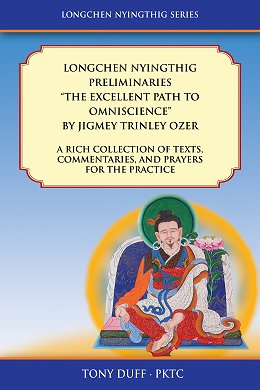
Texts by Jigmey Lingpa and other Tibetan Longchen Nyingthig masters, explanations by Tony Duff
| Title | Longchen Nyingthig Preliminaries, "The Excellent Path to Omniscience" |
| Sub-title | A Rich Collection of Texts, Commentaries, and Prayers for the Practice |
| Author | Tony Duff. Tibetan authors included are Padmasambhava, Jigmey Lingpa, Jigmey Trinley Ozer, Khyentse Wangpo, Yukhog Chadralwa, and Dodrupchen |
| Details | 242 pages, 1 colour plate, 6" X 9" (large format), US$25, available on paper and in PDF e-book format |
| ISBN | paper book 978-9937-824-49-1, e-book 978-9937-572-41-5 |
| Texts | Tibetan texts in Tibetan script included |
| New, improved third edition, March 2017 |
This book centres on the liturgy for doing the preliminary practices of Longchen Nyingthig. It was written by the first Dodrupchen, one of the heart disciples of Jigmey Lingpa. The book features a fresh translation of the liturgy that corrects the many mistakes, omissions, and un-necessary additions found in the several translations available at the moment. At the same time, it words the liturgy in a way that is convenient for recitation in English.
The Tibetan liturgy assumes a high level of understanding of the system and its terminology. Therefore, several Tibetan commentaries have been written to explain it. Four of them are included in the book. The commentary of the first Khyentse Rinpoche, Khyentse Wangpo is presented in order to explain the procedures involved. It is regarded as one of the root texts of the Longchen Nyingthig scriptures. It focusses on the procedures and does not delve into the theory or terminology involved.
To explain the terminology and the theory where needed, the author was encouraged by his lineage gurus to write a major commentary in English. His commentary, the first written by an English lama, has been included. This commentary clarifies the unique terminology of the system and also the meaning of the liturgy in a straightforward but precise way. It also clarifies several very difficult points of the liturgy, such as the refuge section, showing how they should be understood according to the lineage. To write the commentary, the author relied on the extensive oral instructions he has received from a variety of lineage gurus and his extensive reading of Tibetan commentaries. These sources are quoted throughout the commentary.
To make the book even more complete, two commentaries by a great Nyingthig master who lived in East Tibet in the 20th century, Yukhog Chadralwa, have been included. Yukhog Chadralwa was known for having heard an enormous amount of teaching from various masters and having practised it to completion. His writings are filled with oral instructions obtained from various Longchen Nyingthig lineage holders, giving the reader access to the tradition in ways not normally possible. Excerpts from one of his commentaries give very clear presentations of important but little-known aspects of the theory behind the refuge verse, the Vajrasatva practice, and the mandala practice. The other commentary is particularly interesting because it highlights the meditational aspect of the preliminaries, showing how the practice of the preliminaries is really a practice of the innate wisdom mind and how to connect with that key point when doing the practices. This text alone will make the book of interest to practitioners at all levels and not only those who are working on the preliminary practices. His written works are very hard to obtain; these are the first translations of his works to appear in English.
There are a number of prayers and supplications that are usually done with the preliminary practices. Therefore, several prayers and support practices are included. There is the waking practice by Jigmey Lingpa, the speech blessing, and the Prayer that Spontaneously Fulfills Wishes by Padmasambhava. The translation of the Padmasambhava's prayer includes historical material of interest that is part of the original prayer but which is mostly excluded from English translations; this contextual material is important because it helps to arouse faith and devotion so it has been included.
The book contains an extensive introduction that explains the meaning of Longchen Nyingthig Great Completion and all other matters relevant to the book. It also includes a summary of Jigmey Lingpa's encounters with Longchenpa taken from his autobiographies. All parts of the book are copiously footnoted and there is an extensive glossary, too.
If you are doing the Longchen Nyingthig preliminary practices, you will find that this is the clearest and most complete presentation of the practice available. For others, this compilation of materials will give considerable insight into the theory and practice of the Longchen Nyingthig system and clarification of the Dzogchen dharma in general. In addition, there are many comments, definitions, and explanations which will be of great use to translators.
The book contains translations of the following texts:
 | The waking practice by Jigmey Lingpa |
 | The speech blessing |
 | The preliminaries' liturgy by Jigmey Thrinley Ozer called "The Excellent Path to Omniscience" An Ordered Recitation for the Longchen Nyingthig Great Completion Preliminaries |
 | The commentary by Tony Duff called An explanation of the words of "The Excellent Path to Omniscience" |
 | The commentary by Khyentse Wangpo called "The Nectar of Profound Meaning" the Visualization Procedures of the Preliminaries of Longchen Nyingthig Great Completion Wrapped Up |
 | The commentary by Yukhog Chadralwa called "A Summary Arranged in Note Form of Streams of Oral Teaching on the Preliminaries" |
 | Excerpts from the commentary to the practice by Yukhog Chadralwa called "A Compendium of the Preliminaries" |
 | The prayer by Padmasambhava called "The Prayer That Spontaneously Fulfils Wishes" |
Purchase:


Text by Jigmey Lingpa, Instructions by Dza Patrul, and Commentary by Tony Duff
| Title | Longchen Nyingthig Chod, Sound of Dakini Laughter |
| Sub-title | Text by Jigmey Lingpa, Instructions by Dza Patrul, and Commentary by the Author |
| Author | Tony Duff. Tibetan authors included are Jigmey Lingpa and Dza Patrul |
| Details | 180 pages, 2 colour plates, 6" X 9" (large format), US$25, available on paper and in PDF e-book format |
| ISBN | paper book 978-9937-824-47-7, e-book 978-9937-572-40-8 |
| Texts | Tibetan texts in Tibetan script included |
| New, highly expanded second edition, March 2010 |
The root texts of Longchen Nyingthig contain a text for Chod practice. The text is part of the root transmission of the Longchen Nyingthig dharma that Jigmey Lingpa received as mind treasure from Longchenpa. The text includes both an explanation of the practice and a liturgy for doing it. The text is popularly known by its Tibetan name "khadro gayjang", or "Sound of Dakini Laughter". This book contains a fresh translation of the liturgy, one that corrects the many mistakes, omissions, and un-necessary additions found in most translations available at the moment, and especially in the ones that are available free on the internet. The translation was intended to be used as a practice text, and the rhythms and poetry of the Tibetan original have been retained as far as possible.
The Tibetan text assumes a high level of understanding of the system and its terminology. Therefore, several Tibetan commentaries have been written to explain it. The most popular one is by Dza Patrul and is called Profound Foremost Instructions for the Chod Practice Sound of Dakini Laughter. This commentary explains the details of all the visualizations involved in the practice and makes some very important comments about the right and wrong way to practice Chod. Amongst Tibetans, it is regarded as the best companion to Jigmey Lingpa's text. Therefore, the author has translated it, included notes as necessary to clarify it, and included it in the book.
Furthermore, new editions of both Tibetan texts have been made and included. These new editions of the Tibetan texts carefully correct mistakes found in the main Tibetan editions that are available at the moment and especially in the copies of Jigmey Lingpa's text that are floating around on the internet.
Jigmey Lingpa's text contains much which is not explained in Dza Patrul's text. Therefore, the author was encouraged by several lineage holding gurus to write a long commentary that would explain the whole text in a way that would make it accessible to English speakers. The commentary has been included in the book. It is the first true commentary to this text written by a qualified Western teacher.
The author has added an introduction that clarifies many points, a glossary, and many notes to ensure that all details are fully explained. The author explains in detail how this particular practice of Chod is unusual because of being based in Nyingthig Dzogchen dharma. The author knows well, through personal experience of the practice done in one of the main Dzogchen monasteries of Tibet, how the view and practice of this Nyingthig Chod differs from the normal view and practice of Chod. He explains the difference very clearly and extensively in the introduction. His authentic experience and knowledge of the Longchen Nyingthig system has guided the translation of these texts so that they correctly reflect the view of the Longchen Nyingthig Chod practice. If you are a Chod practitioner, you will find this book invaluable. For others who are interested in Dzogchen practice, there are many insights to be gained from the text and the explanations provided with it.
The book contains translations of the following texts:
 | From Longchen Nyingthig: The Chod Practice Sound of Dakini Laughter by Jigmey Lingpa |
 | Commentary to the Chod Practice Sound of Dakini Laughter by Tony Duff |
 | Profound Foremost Instructions for The Chod Practice Sound of Dakini Laughter by Dza Patrul |
 | Jigmey Lingpa's From Longchen Nyingthig: Chod Practice Sound of Dakini Laughter • available here. |
 | Dza Patrul's Profound Foremost Instructions on Chod Practice Sound of Dakini Laughter • available here. |
Purchase:


Text by Jigmey Lingpa, book by Tony Duff
| Title | A Presentation of Instructions for the Development Stage Deity |
| Sub-title | "A Stairway Leading to Akanishtha" by Jigmey Lingpa |
| Author | Tony Duff. Tibetan author is Jigmey Lingpa |
| Details | 180 pages, 2 colour plates, 5.5" X 8.5", US$25, available on paper and in PDF e-book format |
| ISBN | paper book 978-9937-838-63-4, e-book 978-9937-572-42-2 |
| Texts | Tibetan text in Tibetan script included |
The Root Volumes of Longchen Nyingthig Great Completion contains specific texts for the various topics that need to be covered during the transmission of the teaching. One of them is a text by Jigmey Lingpa that gives a complete set of instructions on Development Stage practice, that is, the practice of visualizing a deity. The text, which is one of the core texts of the Longchen Nyingthig transmission of Great Completion, provides an extensive level of instruction in deity practice using a ground, path, and fruition presentation of the subject. The instruction is based on the root tantra of Mahayoga, the Core of the Secret (in Sanskrit, Guhyagarbha), in Tibetan gsang ba snying po. However, it adds instructions on applying the view of Great Completion to the visualization practice. The text is popularly known by its name "Stairway Leading to Akanishtha".
Jigmey Lingpa's text presents many different instructions of Development Stage practice, including the key instruction called The Four Nails Pinning The Life-Forces. The full teaching on the Four Nails should be read in conjunction with it, hence PKTC has published a book of Dza Patrul's teaching on it called Key Issues of Visualization: Four Nails Pinning the Life Forces, "A Melody of Brahma Playing Throughout the Three Worlds".
The author has added an introduction that clarifies many points, a glossary, and many notes to ensure that all the many details of visualizing a deity are fully explained. The introduction clearly shows the special value of this text for those who are practising Great Completion. The differences between deity practice in the Mahayoga and Atiyoga are clearly shown. The author's authentic experience and knowledge of the Longchen Nyingthig system has guided the translation of these texts so that they correctly reflect the view of Longchen Nyingthig.
A new edition of the Tibetan text has been made and included. The new edition carefully correct mistakes found in the main Tibetan editions that are available at the moment.
Download Tibetan texts in TibetD format: available here in • the Root Volumes of Longchen Nyingthig.
Purchase:

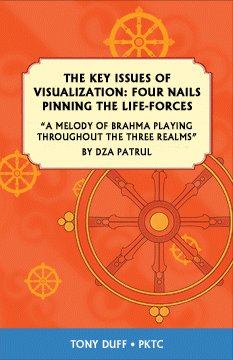
Two texts by Dza Patrul explaining development stage in the Nyingma tradition and Jigmey Lingpa's "Stairway to Akanishta" (see above), book by Tony Duff
| Title | The Key Issues of Visualization: Four Nails Pinning the Life-Forces |
| Sub-title | "A Melody of Brahma Playing Throughout the Three Realms" by Dza Patrul |
| Author | Translation and introduction by Tony Duff |
| Details | 88 pages, 2 colour plates, 5.5" X 8.5", US$20, available on paper and in PDF e-book format |
| ISBN | paper book 978-9937-838-65-8, e-book 978-9937-572-43-9 |
| Texts | Tibetan text in Tibetan script included |
The first Patrul Rinpoche (Dza Patrul Chokyi Wangpo) was a very learned and accomplished master of the 19th century in Tibet. He wrote widely on all aspects of practice. In this text, he explains the most important foremost instruction taught in the Nyingma tradition for Development Stage practice. It is a Nyingma teaching but it is completely applicable to the Development Stage practice taught in all of the schools of Tibetan Buddhism.
The name of the foremost instruction explained in the text is "Four Nails Pinning the Life-Forces". This instruction is a set of four headings which cover all the main topics of Development Stage practice and which are, at the same time, a complete set of instructions for the practice. It goes even further than that: because they are the main topics of Development Stage practice, they also include all of the many sub-topics of the practice. Patrul Rinpoche explains all of this clearly and then enumerates forty different sub-topics, each one being an instruction for Development Stage practice. Moreover, when Dza Patrul explains the Four Nails, he also explains it in terms of the other main instructions for Development Stage practice; for example, he gives an excellent explanation of the subject called "Purifying, Completing, Ripening" in relation to the first nail. Altogether the text is a very rich source of instruction for anyone doing Development Stage practice and an excellent resource for those trying to understand its various details.
The importance of the Four Nails instruction can be understood from the fact that, whenever authors in the Nyingma tradition need to summarize the points of Development Stage practice in one place, they refer either to the Four Nails or to the "Purifying, Completing, Ripening" instruction mentioned above. Because this text explains both sets of instructions it is an ideal way to learn the key points of Development Stage practice.
This teaching is also covered, but in a different way, in the Longchen Nyingthig text on deity practice, which we have also published, called A Presentation of Instructions for the Development Stage Deity; you will want to read both books together.
To the best of our knowledge this is the first time that a clear instruction on the Four Nails and "Purifying, Completing, Ripening" instructions has been translated and published. The Tibetan text, from the Derge Edition of Dza Patrul's Collected Works is unclear in many places and has a number of mistakes in it. Lama Tony carefully edited the text to repair it, then included it in the book with the thought that students could take the book to their teachers and ask for instruction on it. We think the book will be quite useful and popular in this regard.
Download Tibetan text in TibetD format: • available here.
Purchase:


Texts by Dza Patrul, translations, introduction, and book by Tony Duff
| Title | The View and Practice of Quintessence Dzogchen |
| Sub-Title | Three Rare Texts on Nyingthig Dzogchen from Dza Patrul's Collected Works |
| Author | Texts by Dza Patrul, translation, introduction, and book by Tony Duff |
| Details | 220 pages, 6" X 9", US$25, available on paper and in PDF e-book format |
| ISBN | paper book 978-9937-572-64-4, e-book 978-9937-572-65-1 |
| Texts | Tibetan texts in Tibetan script included |
PKTC has translated and published many of the works on Dzogchen written by Dza Patrul, one of the very important early holders of the Longchen Nyingthig lineage. This book came to life with the intention to present all remaining, unpublished works on Dzogchen by Dza Patrul. We found that there were three texts to be included. Each has its own, distinct approach, so there is no overlap of material at all.
All the texts are interesting, but the record of Jigmey Gyalway Nyugu’s appearance immediately following his death to the fourth Dzogchen Rinpoche, Mingyur Namkha’i Dorje, and the teaching given by Jigmey Gyalway Nyugu to him on innermost unsurpassed Great Completion was an unexpected treasure. This teaching falls in the class of “after-passing” teachings given by really great masters of the early Great Completion lineage in ancient India, so it really is very special. The text starts with a record that was written by the fourth Dzogchen Rinpoche upon waking from the transmission. It is followed by a word-by-word commentary composed by Dza Patrul on the basis of the instructions that he received on it. The text is even more interesting for the fact that we get a sense of the person of Jigmey Gyalway Nyugu, one of the most important Longchen Nyingthig lineage holders but one whose actual works and teachings are not all that well known; in fact, we think this is the first teaching of Jigmey Gyalway Nyugu to be published in English.
There are so many wonderful points to the collection of texts in this book and they present such an important piece of early Longchen Nyingthig history that an especially long introduction explaining the lineage, the specific people involved, the meaning of the texts, and so on has been added to help the reader gain the full import of this book.
The book contains a translation of the following texts:
 | From the Supreme Vehicle Ati: Foremost Instructions Clearly Showing Actuality by Dza Patrul |
 | “Lamp for a Dim Room” The Meanings of the Key Points of Secret, Quintessence Great Completion’s Tantras Protected with Thorough Distinctions by Dza Patrul |
 | “Luminosity’s Appearance Aspect”, The Ultimate Key Points in the Practice of Great Completion: Root Text and Commentary by Dza Patrul |
Download Tibetan text in TibetD format: not available yet.
Purchase:


Texts of Indian masters, a major explanation by Padma Karpo, with translations and explanations by Tony Duff
| Title | The Bodyless Dakini Dharma: The Dakini Hearing Lineage of the Kagyu |
| Sub-title | The original Vajra Verses, sadhana, and Padma Karpo's Thorough Explanation |
| Author | Tony Duff |
| Details | 190 pages, 1 colour plate, 5.5" X 8.5", US$25, available on paper and in PDF e-book format |
| ISBN | paper book 978-9937-824-48-4, e-book 978-9937-572-16-3 |
| Texts | Three Tibetan texts in Tibetan script included |
| New, highly expanded second edition. Published March, 2010 |
Synopsis / back cover text:
The hearing lineage Chakrasamvara and Vajrayogini teachings were obtained in person by Tilopa when he stormed the palaces of Chakrasamvara and Vajravarahi. The teachings from Vajravarahi became known as the Bodyless Dakini teaching and were passed down through the Kayu lineage. The Dakini Hearing lineage as it is called is one of the root teachings of the Kagyu. It is a very important for Kagyu practitioners in general and especially for Vajrayogini and Chakrasamvara practitioners.
This book is a major exposition of the Bodyless Dakini teaching. A comprehensive introduction lays out the history of the teaching and its transmission, the principal figures involved, the texts of the system, and more. The body of the book includes translations of the root texts of the system and a major exposition of the system by the fourth Drukchen, All-knowing Padma Karpo.
The book was compiled by Tony Duff, well known teacher and translator, and long time scholar-practitioner of Kagyu and Nyingma lineages.
Full explanation:
Two of the key teachings in the Kagyu system are the hearing lineage Chakrasamvara and Vajrayogini teachings which Tailopa obtained in person by storming the palaces of Chakrasamvara and Vajravarahi respectively. The instructions received from Vajravarahi became known as the dharmakaya teaching of the Bodyless Dakini and the teachings were passed down in what is known as the Dakini Hearing Lineage.
The Dakini Hearing lineage is one of the root teachings of the Kagyu. It is a very important teaching for any Kagyu practitioner but especially for anyone doing the Vajrayogini or Chakrasamvara practices.
This book is a major exposition of the Kagyu Dakini Hearing lineage teaching. It begins with a long introduction to the Dakini Hearing Lineage. The introduction gives the history of the teachings and its transmission, principal figures involved, the texts of the system, and a great deal of background information. It also tells the story of the criticisms levelled at the system by the Sakya Pandita and the very strong refutation of his criticisms by the famous fourth Drukchen, Padma Karpo. Three key texts of the system are presented in the body of the book. The first text is the very root of the Bodyless Dakini dharma, the original teaching spoken out of empty space by Vajravarahi to Tailopa, and the teachings that he in turn spoke out of empty space to Naropa. Following that, there is the original Indian sadhana for the practice. Then comes a very long explanatory text called The Thorough Explanation by Padma Karpo that shows the whole path of realization of these Vajrayogini teachings.
The book is a handbook of the Bodyless Vajrayogini teachings that contains much information that will be of interest to Vajrayogini and Chakrasamvara practitioners. The book will be of general interest to all Kagyu followers. It will also be of interest to Sakya followers and to historians interested in Sakya Pandita's attacks on the Kagyu lineage. It will be of special interest to followers of the Drukpa Kagyu.
One of the interesting features of the book is the inclusion of a major text of Drukchen Padma Karpo. The Drukchens have been the heads of the Drukpa Kagyu for many centuries. All of them are known for their knowledge and realization. However, Padma karpo stands out as the great writer of the lineage. His works were so well-written and well-informed that he quickly became one of the greatest authors not just of his own Drukpa Kagyu lineage but of the Kagyu tradition as a whole. The work of his included in this book is one of his major works.
The book is available through us using the links below and through major book sellers.
The book contains translations of the following texts:
 | The Root Vajra Verses called "The Dharma of the Bodyless Glorious Vajradakini", one of the root texts from India that establishes the Bodyless Dakini dharma |
 | The Sadhana Called "Bodyless Dakini", another of the root texts from India that establishes the Bodyless Dakini dharma |
 | "Tincture of Dharma", A Thorough Explanation of the Bodyless Dakini Dharma by All-Knowing Padma Karpo, one of the most complete and important Tibetan commentaries on the original Indian Bodyless Dakini dharma texts |
Purchase:

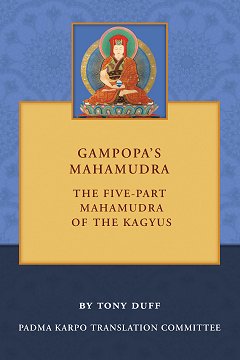
Texts by Padma Karpo, Situ VIII, and others, book by Tony Duff
| Title | Gampopa's Mahamudra |
| Sub-title | The Five Part Mahamudra of the Kagyus |
| Author | Tony Duff |
| Details | 204 pages, line drawings, 6" X 9", US$25, available on paper and in PDF e-book format |
| ISBN | paper book 978-9937-206-07-5, e-book 978-9937-572-24-8 |
| Texts | Tibetan texts in Tibetan script not included |
Gampopa taught Mahamudra to his heart disciple Phagmo Drupa in a specific way that made it into a five-part practice. Phagmo Drupa practised it then taught it widely to his disciples. From there, "The Five-Part Mahamudra", as it is called became an important part of the Kagyu approach to Mahamudra.
This book is a complete reference to the Five-Part Mahamudra teaching. It contains translations of several key texts by important authors of Drigung, Drukpa, and Karma Kagyu lineages. It contains unpublished selections from Gampopa's Collected Works including his exchanges with Phagmo Drupa that led to the Five-Part system. It contains texts that explain the entire practice from Jigten Sumgon, The translator from Throphu, Situ Chokyi Jungnay, and the Zhamar Konchog Yanlag. It ends with a very extensive oral explanation of the system from the current Benchen Tenga Rinpoche.
This is the first book to present the Five-Part Mahamudra system in its entirety and is unusual for the extensive translations of source texts contained. The introduction by the author provides a very clear overview of the tradition and full information on the texts in the book.
The book contains translations of the following texts:
 | A Written Instruction Coming from the Throphu Kagyu on the Five-Part Mahamudra by The Translator from Throphu, Jampay Pal |
 | The Source of the Jewels of Experience and Realization, The Ocean-Like Instructions on the Five Parts. The instructions by Jigten Sumgon arranged and commented on by Zhamar Konchog Yanlag |
 | "Mind Harvest", An Instruction on the Five-Part Mahamudra by All-knowing Padma Karpo |
 | A Written Instruction on the Five-Part Mahamudra by All-knowing Situ Chokyi Jungnay |
Purchase:

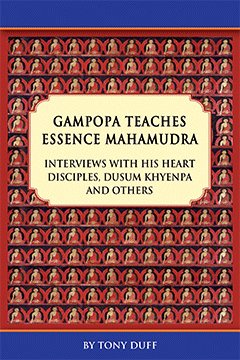
Interviews with his Heart Disciples, Dusum Khyenpa and Others, book by Tony Duff
| Title | Gampopa Teaches Essence Mahamudra |
| Sub-Title | Interviews with his Heart Disciples, Dusum Khyenpa and Others |
| Author | Tony Duff |
| Details | 342 pages, 3 colour plates, 6" X 9" (large format), US$30, available on paper and in Kindle e-book format |
| ISBN | paper book 978-9937-572-08-8, e-book 978-9937-572-09-5 |
| Texts | Tibetan texts in Tibetan script not included |
This book began as a translation of the "Interviews" section of Gampopa's Collected Works. Interviews or "question and answer sessions" as they are literally called in Tibetan are records of the personal interviews of a great teacher with those who come to see him. These are amongst the most interesting writings to be found in Tibetan literature because of the very personal quality found in them. The interviews section of Gampopa's Collected Works consists of interviews with four of his greatest yogin disciples—the first Karmapa Dusum Khyenpa, source of most of the lesser Kagyu lineages Phagmo Drupa, Lord Gomtshul, and Yogin Choyung.
The outstanding feature of these interviews is that Gampopa [1079–1153] uses them to give private teachings on Essence Mahamudra, the ultimate transmission of Mahamudra within the Kagyu lineage. In one session after another, Gampopa reveals all the teachings of Essence Mahamudra to his foremost disciples in a thoroughly personal, pointed, and practical manner. Another feature of these interviews is the very clear picture they paint of how the ultimate Mahamudra teaching was given in the early days of the Kagyu lineage. Many important points of the teaching, some which seem to have been lost historically, can be understood from them. Yet another feature of these interviews is that the majority of them are notes that were taken on the spot or written out just after the interviews. As such, they are historical records which give us a very personal sense of Gampopa and these great disciples and what they went through on their personal journeys to enlightenment. More than that though, the reader gets a distinct impression of the personalities involved through their own, hand-written records.
Gampopa tells the story of his own dharma journey on two occasions in the book. Here he tells it in his own words to Dusum Khyenpa who has recorded it for us:
 Read a preview of
Read a preview ofDusum Khyenpa's interviews
Because the interviews are so focussed on Gampopa's presentation of Mahamudra, two more texts from his Collected Works were added to give a further sense of his way of teaching it: first, a short text which is the root of his famous "Four Dharmas of Gampopa" teaching; and second a medium-length text which records an oral teaching he gave on the entire path of Mahamudra. These two texts form a perfect introduction to the teachings contained in the interviews. A point of interest is that the first addition makes the original teaching of "The Four Dharmas of Gampopa" available in English for the first time. Gampopa's explanation of the Four Dharmas differs a little from some modern-day presentations of it, a point which is clarified for the reader in the introduction to the book.
A very lengthy introduction has been provided to help the reader see and understand the many interesting threads contained in this book, including paraphrases of the entirety of Phagmo Drupa's interviews. Extensive footnotes and a long glossary have been provided so that the reader can clearly understand all the details involved.
The book contains translations of the following texts:
 | The Four Dharmas in Brief |
 | Precious Garland of the Supreme Path |
 | Lord Dvagpo's Personal Advice and Lord Gomtshul's Interviews |
 | Dusum Khyenpa's Interviews |
 | Lord Phagmo Drupa's Interviews |
 | Yogin Choyung's Interview |
Download Tibetan texts in TibetD format: not available yet. These texts can be found in Gampopa's Collected Works.
Purchase:

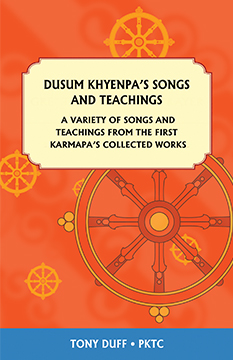
Songs and teachings on Mahamudra by the first Karmapa, book by Tony Duff
| Title | Dusum Khyenpa's Songs and Teachings |
| Sub-title | A Variety of Songs and Teachings from the First Karmapa's Collected Works |
| Author | Translations, biography, and introduction by Tony Duff |
| Details | 84 pages, 1 colour plate, 5.5" X 8.5", US$20, available in paper and PDF e-book formats |
| ISBN | paper book 978-9937-903-14-1, e-book 978-9937-572-20-0 |
| Texts | Tibetan texts in Tibetan script included |
The Collected Works of Dusum Khyenpa, the first Karmapa, consists of about four volumes of texts. It is very rare, almost non-existent. We managed to obtain a copy and save it from extinction. You can obtain a copy from our • free digital Tibetan texts page.
Much of Dusum Khyenpa's Collected Works are taken up with complete sets of teachings on the various yidams of the Kagyu lineage that he received and practised. However, there is a small section containing eight dohas (spontaneous songs of spiritual realization) sung by Dusum Khyenpa. There is also a short text that gives the transmission of a specific Mahamudra teaching called "Mahamudra, the Thunderbolt". We translated seven of the eight dohas and the Mahamudra teaching and put them together into a small book, for the sake of the many followers of the Karmapa and the Kagyu teachings in general.
As a matter of interest, we were amazed to find a text in Dusum Khyenpa's Collected Works that gives specific details of how to do the practice called "Dead Entry", a practice which was supposedly eliminated from the Kagyu transmission because of the dangers involved. It is often said that the teaching disappeared with Marpa the Translator but this entry in the Collected Works shows that it really was transmitted on through the lineage.
The book contains translations of the following texts:
 | Mahamudra, The Thunderbolt |
 | Dohas two to nine of the doha collection in the Collected Works |
Purchase:

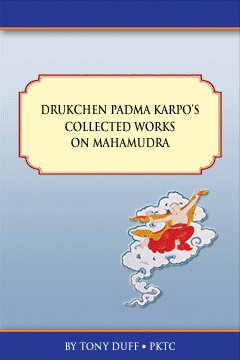
Texts by Padma Karpo, book by Tony Duff
| Title | Drukchen Padma Karpo's Collected Works on Mahamudra |
| Author | Tony Duff |
| Details | 246 pages, 1 colour plate, 6" X 9" (large format), US$25, available on paper and in Kindle e-book format |
| ISBN | paper book 978-9937-572-01-9, e-book 978-9937-572-00-2 |
| Texts | Tibetan texts in Tibetan script not included |
This book contains all of Padma Karpo's writings on Mahamudra as found in his Collected Works. Padma Karpo [1527-1592 C.E.] was the fourth Drukchen or leader of the Drukpa Kagyu school of Tibetan Buddhism. He is one of the most famous of all Tibetan authors, and is well-known for his erudite explanations of difficult subjects.
A few of the smaller texts in this book have been seen in English. For example, the short but pithy Notes on Mahamudra, which is widely used in all Kagyu lineages these days as an instruction manual on the Four Yogas of Mahamudra, has been translated a number of times, beginning with Evans-Wentz's famous first effort. It has been freshly translated to solve various problems with the earlier translations. This raises an important point. All the translations in this book are based on extensive personal teaching received from various Drukpa Kagyu masters over the span of a decade, often privately and directly in Tibetan. The Drukpa Kagyu has its own way of understanding the view and practice; existing translations by followers of other Kagyu lineages go astray in places because of lack of knowledge of the particulars of Drukpa Kagyu view and meditation. This book does not suffer from that problem. To the contrary, it is the first major presentation of texts of the Drukpa Kagyu in English done by someone who has studied closely with the Drukpa Kagyu.
Despite the fact that the Drukpa Kagyu view is presented in these texts, the book should be of immense value to anyone who is studying and practising Mahamudra. There are many explanations of the Four Yogas of Mahamudra in here which show the whole system in a level of detail not seen before. A bonus is that, in one text, Padma Karpo quotes extensively from his predecessor, the second Drukchen Gyalwang Je, who was famous for the brilliance of his expositions on tantra. Another gem is Padma Karpo's explanation of a song of Saraha on the non-dual view which came to Marpa the Translator in a dream.
A lengthy introduction has been provided and ample notes and a long glossary have been provided to explain technical details where needed.
The book contains translations of the following texts:
 | Jetsun Tillipa's Instruction to Naropa commonly known as "The Ganges Mahamudra" |
 | The Guru of All Explanations That Thoroughly Distinguish the Ascertainments of The Four Yogas |
 | An Explanation of the Four Yogas Called "An Eye to Look at the Definitive Meaning" |
 | An Explanation of the Four Yogas Points Out Superfact |
 | Notes on Mahamudra |
 | "A Mirror on Mind", Foremost Instructions on the Heart Meaning |
 | "Mind Harvest", An Instruction on Five-Part Mahamudra |
Download Tibetan texts in TibetD format: not available yet. The texts in this book are part of the Collected Works of Padma Karpo which occupy 22 to 28 volumes, depending on the edition. The bulk of the works in Padma Karpo's Collected Works are available in the Drukpa Kagyu Heritage Project Collection which is available for purchase from PKTC.
Purchase:

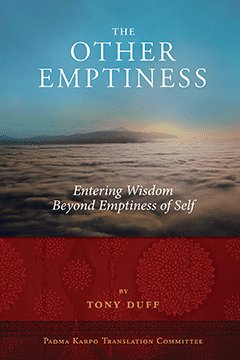
A complete Explanation of Other Emptiness by Tony Duff, several Tibetan sources included
| Title | The Other Emptiness |
| Sub-Title | Entering Wisdom Beyond Emptiness of Self |
| Author | Tony Duff |
| Others | Dolpopa Sherab Gyaltsen, Khenpo Tsultrim Gyatso, Jamgon Kongtrul the Great, Mipham, Longchenpa, and many others |
| Details | 330 pages, 1 colour plate, 6" X 9" (large format), US $45, available on paper and in PDF e-book format |
| ISBN | paper book 978-9937-572-67-5, e-book 978-9937-572-68-2 |
| Texts | Tibetan texts in Tibetan script not included |
Other Emptiness is the view of emptiness that goes with wisdom. It has long been thought amongst Westerners that the view of emptiness championed by the Gelug tradition following the views of Tsongkhapa is the one and only view of emptiness in the Buddhist teachings. However, that is not the case. The majority of Tibetan Buddhists accept two approaches to emptiness, a logical approach called empty of self and a non-conceptual approach called empty of other. This book clearly presents all of these views and shows how the empty of other type of emptiness is actually the ultimate teaching of the Buddha, the teaching on how to enter non-dual wisdom.
Other emptiness has usually been thought of amongst Westerners who have heard of it as a very complicated and difficult philosophy. It is subtle, that is true, because it describes what it is like to be in wisdom. However, it was not taught as a difficult philosophy. Rather, it was taught as a practical teaching on how to enter non-dual wisdom. The book explores this point at length.
The book was written to be useful for all levels of reader. It starts simply, giving a clear explanation of the Buddha's non-dual teaching and how the other emptiness teaching is part of that. Then it goes into details about the history and teaching of other emptiness. Finally, it goes in to great technical detail concerning the other emptiness teaching, and supports that with extensive materials from various Tibetan teachers. Unlike many of the books on other emptiness that have appeared, this book does not only present the theory of other emptiness but keeps a proper balance between showing the theory of other emptiness and presenting the practice-based reality of the teaching.
The book is divided into four parts, each one a set of presentations from someone knowledgeable of the subject. The first part is several chapters written by the author in plain English in order to get the reader under way. Following that, there are sections embodying the explanations of Dolpopa Sherab Gyaltsen, Khenpo Tsultrim Gyatso, and Jamgon Kongtrul the great. Ample introductions, glossaries and so on are provided.
Aside from many oral explanations, the book contains translations of the following texts:
 | The Chapter on Tathāgatagarbha from Mountain Dharma: An Ocean of Definitive Meaning by Dolpopa Sherab Gyaltsen |
 | A Brief Discussion of The Rise of the Other Emptiness Middle Way Called "The Music of Talk on the Definitive Meaning" by Khenpo Tsultrim Gyatso (previously not seen in English). |
 | Introductory Section from A Complete Commentary to the Great Vehicle Treatise The Highest Continuum which Connects to Heart Meaning using the Explanation System of the Path of Direct Perception, Called "The Lion's Roar of the Non-Regressing" by Jamgon Kongtrul the Great |
 | The Section from: The Treasury which is an Encyclopædia of Knowledge on Thorough Ascertainments of Provisional and Definitive Within the Three Wheels, and of the Two Truths by Jamgon Kongtrul the Great |
 | The Practice Section from Instructions for Practising the View of the Other Emptiness Great Middle Way, "Light Rays of Stainless Vajra Moon" by Jamgon Kongtrul the Great |
Download Tibetan texts in TibetD format: partially available. The entire Treasury of Knowledge is available free from our • Tibetan texts page.
Purchase:

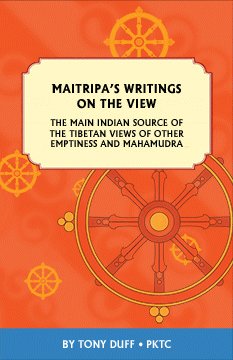
The main Indian source of the Tibetan Views of Other Emptiness and Mahamudra, book by Tony Duff
| Title | Maitripa's Writings On The View |
| Sub-title | The Main Indian Source of the Tibetan Views of Other Emptiness and Mahamudra |
| Author | Translations and extensive commentary to each text by Tony Duff |
| Details | 102 pages, line drawings, 5.5" X 8.5", US$20, available on paper and in PDF e-book format |
| ISBN | paper book 978-9937-903-17-2, e-book 978-9937-572-46-0 |
| Texts | Tibetan texts in Tibetan script included |
Maitripa was a great Indian Buddhist master who was a contemporary of Naropa. He was regarded as one of the most knowledgeable people of his time on the Buddhist view. For that reason, Naropa told Marpa the Translator that he should not get the view from him but should go to Maitripa and get it from him. Thus Maitripa became the source of the view for the Kagyu lineage. Maitripa is also famous for having re-discovered the Uttaratantrashastra of Maitreya which had been lost till that time. Having recovered the text from an old stupa, Maitreya appeared to him and transmitted the profound meaning associated with that text. In that way, Maitripa became a central figure in the transmission of what is called "the profound meditation system of Maitreya". In many ways, he was the source of the Other Emptiness (gzhan stong) style teaching of Maitreya and Asanga that came into Tibet. For all these reasons, he is regarded as an important figure within Tibetan Buddhist history and is particularly important to the Kagyu and Nyingma.
A number of Maitripa's writings were included in a compilation of important Indian Buddhist texts which is simply called "The Main Texts of India". It is a very old compilation, dating from the early days of the second wave of dharma that came into Tibet. Maitripa's writings are mostly very short and pithy and have the quality of oral teaching. These writings always deal with the view and are very important to followers of the Other Emptiness teaching because they definitely show that view.
This book is a compilation of several of these writings. They were selected from the whole set of Maitripa's writings because they very clearly show his presentation of the Other Emptiness view in both sutra and tantra contexts. There are texts on Madhyamaka, Co-emergence, Chakrasamvara practice, and so on. The book has the texts in translation with a full set of notes and commentary by the author to make the meaning of the very terse writing clear. Kagyu practitioners who are interested in the view will find the book very useful and Chakrasamvara practitioners in general will appreciate the Chakrasamvara text. The book can be previewed by downloading a free version of the book that does not have the notes and commentary from our free texts page.
We strongly recommend reading Point of Passage Wisdom, A Great Vehicle Sutra and Mipham's Lion's Roar that Proclaims Zhantong as supports for this book.
The following writings of Maitripa are included in the book:
 | Great Bliss Clarified |
 | Sixty Verses on Co-Emergence |
 | Utterly Clear Teaching of Unification |
 | Definitive Teaching on Dreams |
 | Clear Teaching on Utter Non-Dwelling |
 | Full Teaching of Suchness |
 | Six Verses on Madhyamaka |
Purchase:

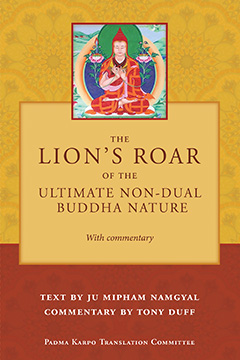
Text by Ju Mipham Namgyal, Commentary by Tony Duff
| Title | The Lion's Roar of the Ultimate Non-Dual Buddha Nature |
| Sub-Title | With commentary |
| Author | Text by Ju Mipham Namgyal, Commentary by Tony Duff |
| Details | 254 pages, 1 colour plate, 6" X 9", $US 25, available on paper |
| ISBN | paper book 978-9937-572-79-8, e-book 978-9937-572-80-4 |
| Texts | Tibetan text in Tibetan script included |
The teaching of the Buddha hinges around the one point that sentient beings, meaning beings having a mind, have within them the potential to become a buddha. If they did not possess that potential, it would not be possible for them to become buddhas and the rest of the Buddhist teaching would be an interesting but useless philosophy. Therefore, the topic of buddha nature is especially important.
The Buddha taught buddha nature in steps, with each more profound than the previous one. He first taught it as a seed that could be developed, like growing a plant. After that he taught that it is, like all phenomena, empty. Finally, he taught it as actual buddhahood present in the mind. This last level of teaching is regarded by most Tibetan Buddhist schools as the most profound teaching of the sutras, the very essence of what the Buddha was trying to communicate to his followers.
The ultimate teaching of the buddha nature as actual buddhahood was given in the third and final turning of the wheel of dharma. It does not show emptiness as taught in the second turning of the wheel to be most important but teaches non-dual, luminosity wisdom totally beyond all of the elaborations—the conceptual stuff—of dualistic mind as the most important point. It is part of the teaching of the highest tantras, Mahamudra and Dzogchen, so is especially important for practitioners of those systems.
It is easy to misunderstand this very profound teaching. Therefore, there is a strong need to clearly and correctly establish what buddha nature actually is and what the Buddha's teachings on it actually meant. The very learned Nyingma teacher Ju Mipham Namgyal gave a teaching on buddha nature that was recorded and published by his students. The resulting text was titled The Lion's Roar that is A Great Thousand Doses of Sugata Essence where sugata essence is one of many names for buddha nature. The text first examines the question of why buddha nature is present in all beings having mind. then goes on to present the ultimate sutra teachings in which buddha nature is understood to be buddhahood actually present in beings.
Mipham's teaching needs clarification, so a very extensive explanation has been provided by the author of the book in order to make this ultimate teaching of the sutras and by extension of the tantras available to all. As with all of our books, an extensive introduction, glossary, and so on are provided to assist the reader.
Note Mipham's text is one of a pair of texts that go hand in hand with each other. The ultimate teaching of buddha nature is based in emptiness of other, therefore Mipham also taught on that topic in what became the sister text to this The Lion's Roar That Proclaims Other Emptiness. We also strongly recommend the great exposition of Other Emptiness found in the book The Other Emptiness, Entering Wisdom Beyond Emptiness of Self.
The book contains a translation of the following text:
 |
The Lion's Roar that is A Great Thousand Doses of Sugatagarbha by Ju Mipham Namgyal |
Download Tibetan text in TibetD format: • available here
Purchase:


Text by Ju Mipham Namgyal, book by Tony Duff
| Title | The Lion's Roar That Proclaims Other Emptiness by Ju Mipham Namgyal |
| Author | Translation, introduction, and commentarial notes by Tony Duff |
| Details | 88 pages, 1 colour plate, 5.5" X 8.5", US$15, available on paper and in PDF e-book format |
| ISBN | paper book 978-9937-824-46-0, e-book 978-9937-572-45-3 |
| Texts | Tibetan texts in Tibetan script included |
Ju Mipham Namgyal is one of the best known authors of the Nyingma tradition. He was a prolific writer with an extraordinary knowledge of his own and others' dharma traditions. He wrote many texts on philosophical issues including a pair of commentaries on Zhantong (Other Emptiness). Of them, the first focusses on the meaning of Other Emptiness and the second focusses on the meaning of sugatagarbha taken from an Other Emptiness perspective. The book here contains a translation of the first of the two texts.
Lama Tony has had many teachings on Other Emptiness from various important teachers both Kagyu and Nyingma and is very knowledgeable of the subject. In particular, he received extensive commentaries on this text in private from Khenpo Palden Sherab, Khenpo Thrangu Rinpoche, Khenpo Tsultrim Gyatso, and Traleg Rinpoche. The translation in this book reflects Lama Tony's considerable knowledge of Zhantong in general and his deep understanding gained through the commentaries received from these very learned Tibetan teachers and the many texts on the subject that he has read. Although there are other translations available, the reader will find this one particularly clear. Also, the reader will find that the threads of logic running through the long section of very difficult philosophical argument are outstandingly clear. Lama Tony has become well-known for his careful use of innovative terminology, all based in traditional explanations of the meaning of the terms, and this text on the view is greatly helped by it.
We strongly recommend reading Point of Passage Wisdom, A Great Vehicle Sutra and Maitripa's Writings on the View as supports for this book.
A major work is in progress which will put together the translation contained in this book with a very extensive commentary to the text written by Lama Tony. The commentary will be based especially on detailed commentaries received from Khenpo Palden Sherab and Khenchen Thrangu Rinpoche. It will not be available for some time so this book, containing the root text, has been published to help the many students who are now studying this text.
In addition, another major work on Other Emptiness is being readied for publication. This work explains Other Emptiness very extensively, presenting many texts from the Kagyu tradition. Many Westerners have developed the idea, from reading texts like this of Mipham, that Other Emptiness is all about extremely difficult philosophy. In fact, it is not; it is a teaching meant for practice! This other major work will show the practical side of Other Emptiness.
Download Tibetan text in TibetD format: • available here.
Purchase:


Text by Gyalwang Je, book by Tony Duff
| Title | A Juggernaut of the Non-Dual View |
| Sub-Title | Ultimate Teachings of the Second Drukchen, Gyalwang Je |
| Author | Tony Duff |
| Details | 290 pages, 1 colour plate, 6" X 9" (large format), US25, available on paper and in Kindle e-book format |
| ISBN | paper book 978-9937-572-07-1, e-book 978-9937-572-06-4 |
| Texts | Tibetan text in Tibetan script not included |
This is a remarkable book with many interesting themes. It presents a translation of the text entitled "Chariot of Establishment", Treasure Trove of a Mind Absorbed in the Profound Meaning by the second Drukchen [1428-1476 C.E.] or leader of the Drukpa Kagyu school of Tibetan Buddhism. To begin with, it is of interest simply because it is the first major text of Drukpa Kagyu teachings to have been translated into English.
The text is a compilation of over sixty different oral teachings given by the second Drukchen. The compiler, an attendant, tells us that the teachings included were selected because they establish the ultimate, non-dual view of the Kagyu tradition as it is presented by the Drukpa Kagyu. The text begins with a long teaching on the view of the Kagyu in general, making it of interest to all Kagyu followers. An important feature of this teaching is that it clearly shows the Other Emptiness approach which is at the root of the Kagyu view, though does so according to the earliest teachings of the Kagyu lineage in which the name "Other Emptiness" is not mentioned. Through it, we see how Other Emptiness was taught originally in the Kagyu and we see how the Drukpa Kagyu in particular presents the Other Emptiness view of the Kagyu without using the name "Other Emptiness".
The text continues to a second long teaching in which the second Drukchen neatly establishes the view of the tantras as non-dual wisdom seen in direct perception. In doing so, he cleanly chops the Tibetan Buddhist schools who are infamous for insisting that the emptiness of the second turning of the wheel of the sutra teaching is the utltimate non-dual view. This is a fascinating chapter because it shows a logic to establishing the view which has rarely been seen in the West to this point. It will certainly give academics who have thought that the emptiness of the Middle Way is the ultimate presentation of the view something to think about.
The text then presents many smaller teachings on the view, always with reference to the non-dual view of Kalachakra as the ultimate way to establish the view. Thus, the book also contains many teachings on tantra in general as well as many interesting points from the Kalachakra. For instance, there are clear explanations of mother, father, and non-dual tantra and how each demands a different approach. One chapter has a fascinating presentation which shows the meaning of Kalachakra; it shows that the commonplace translation of Kalachakra as "Wheel of Time" is mistaken. Read a preview of the book here:
 Read a preview of chapter 49
Read a preview of chapter 49on the meaning of Kalachakra
A long introduction by the author, giving a history of the lineage, a guide to the Other Emptiness view and how it is presented in the various Kagyu schools, and more will be of great help to readers of all levels. A second chapter by the author is dedicated to clarifying the meaning of the first and largest chapter on the view.
Obviously, the book will be of great interest to Drukpa Kagyu followers. However, it should be of great interest to a wider audience because it shows how the Kagyus express the ultimate, non-dual view and it also shows how the practice of tantra is the ultimate approach to the Buddha's teaching. Personally, I find this a difficult book to summarize because it has so many differing threads, all of which are of interest.
The book contains translations of the following texts:
 | "Chariot of Establishment", Treasure Trove of a Mind Absorbed in the Profound Meaning |
Download Tibetan texts in TibetD format: not available yet. This work is part of the Second Drukchen Kunga Paljor's Collected Works. Much of his collected works are available in the Drukpa Kagyu Heritage Project Collection which is available through PKTC.
Purchase:


Explanations by Khenpo Tsultrim Gyatso and Tony Duff
| Title | The Theory and Practice of Other Emptiness Taught Through Milarepa's Songs |
| Author | Tony Duff |
| Details | 166 pages, 5.5" X 8.5", US$20, available on paper and in Kindle e-book format |
| ISBN | paper book 978-9937-572-10-1, e-book 978-9937-572-11-8 |
| Texts | Tibetan texts in Tibetan script included |
Back Cover Text: Other Emptiness, or Zhantong in Tibetan, is the most profound view taught by the Buddha. It is the very basis of the majority of Tibetan Buddhist schools, though it has been overshadowed by the views of some schools who have argued against it. As a result, it has not been well understood in the West, where it is often thought of as a complicated and possibly questionable philosophical view. In fact, Other Emptiness is the penultimate teaching of the sutras and the root of all tantras. This book shows for the first time that the Buddha did not teach this ultimate of views as a complicated philosophy for scholarly argument but as a practical view to be used for the attainment of enlightenment.
The teachings of the Kagyu school of Tibetan Buddhism have been based on Other Emptiness from the beginning. The early lineage-holder Milarepa sang many songs which present it and two especially important ones are presented in this book. Fresh translations of the songs come with full explanations based on teachings heard from the Kagyu masters Khenpo Tsultrim Gyatso, Thrangu Rinpoche, and others. These explanations have the special feature of being the actual instructions of the lineage. They are practical in nature and free of the convoluted philosophical argument often but mistakenly claimed to be the meaning of Other Emptiness. Thus, for the first time in English, the teaching of Other Emptiness is clearly shown as a practical instruction, using the teachings of the Kagyu lineage.
 Read a preview of the book
Read a preview of the bookThe author has received extensive explanations on the Middle Way view during nearly forty years of close association with eminent teachers of all four Tibetan Buddhist schools, so has an unusually clear and comprehensive understanding of the Other Emptiness view. He has recently written a series of books to clarify the meaning of Other Emptiness. This book has an extensive introduction which will go far towards clarifying the view and meditation of Other Emptiness for scholars and practitioners alike. Practitioners who are scared off by books on philosophy should not be put off by talk of the view—this is a book for every practitioner because it shows how to use the ultimate view and meditation taught by the Buddha a path to enlightenment.
The book contains translations of the following texts:
 | Milarepa's Song: "An Authentic Expression of the Middle Way" |
 | Milarepa's Song: "Ultimate Ground, Path, Conduct, and Fruition" |
Download Tibetan texts in TibetD format: These songs can be obtained from the collection Life and Songs of Milarepa which is available on our • Tibetan Texts page here.
Purchase:

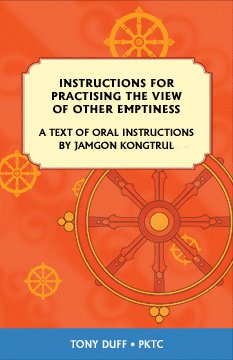
A Text of Oral Instructions from the Jonang Lineage by Jamgon Kongtrul, book by Tony Duff
| Title | Instructions for Practising the View of Other Emptiness |
| Sub-Title | A Text of Oral Instructions by Jamgon Kongtrul |
| Author | Tony Duff |
| Details | 150 pages, 1 colour plate, 5.5" X 8.5", US$20, available on paper and in Kindle e-book format |
| ISBN | paper book 978-9937-572-03-3, e-book 978-9937-572-02-6 |
| Texts | Tibetan text in Tibetan script included |
This is the translation of a text written by Jamgon Kongtrul Yontan Gyatso after receiving the teachings of the Jonang lineage from the Jonang throne-holder of his time. It is a manual on how to actually practice Other Emptiness, and puts to rest once and for all the idea which has developed that Other Emptiness is merely a difficult philosophy. Thrangu Rinpoche asked me to translate it many years ago because it is one of the few texts available that actually shows the practice of Other Emptiness.
Back Cover Text: Other Emptiness, or Zhantong in Tibetan, is the most profound view taught by the Buddha. It is the very basis of the teaching of the majority of Tibetan Buddhist schools, though has been overwhelmed by some reactive Tibetan Buddhist schools who have argued against it. As a result, it has not been well understood in the West, where it is often thought of as a complicated philosophical view enshrouded in argument. In fact, Other Emptiness is the penultimate teaching of the sutras and the root of all tantras. This book unequivocally shows that the Buddha did not teach this ultimate of views as a complicated philosophy for scholarly argument but as a practical view to be used for the attainment of enlightenment.
The author has received extensive explanations on the Middle Way view during nearly forty years of close association with eminent teachers of all four Tibetan Buddhist schools, so has an unusually clear and comprehensive understanding of the Other Emptiness view. He has recently written a series of books which show Other Emptiness from Kagyu, Nyingma, and Jonang perspectives. This book showcases an instruction manual for the actual practise of the Other Emptiness view. The manual was written by Jamgon Kongtrul, one of the great masters of the Kagyu school. He wrote the manual after going to the throne-holder of the Jonang school, who gave him the entire Jonang transmission of Other Emptiness.
This book has an extensive introduction which will go far towards clarifying Other Emptiness for scholars and practitioners alike. The introduction examines Other Emptiness from many sides, so that even readers who are not technically inclined can understand it. For those who are technically inclined, the text itself provides a wealth of detail on how to develop the view and do the meditation of Other Emptiness.
The book contains a translation of the following text:
 | Instructions for Practising the View of the Other Emptiness Great Middle way, "Light Rays of Stainless Vajra Moon" by Jamgon Kongtrul Yontan Gyatso |
Download Tibetan text in TibetD format: not available yet. This text comes from Jamgon Kongtrul Yontan Gyatso's Collected Works.
Purchase: